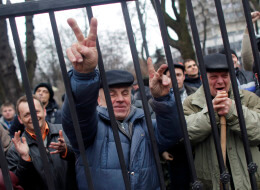About the Author

Michael Vlahos is Professor of Strategy at the United States Naval War College. He is the author of Fighting Identity: Sacred War and World Change, an analysis of how war — as sacred ritual — shapes collective identity.
He holds a Ph.D. in International Relations from the Fletcher School of Law and Diplomacy, Tufts University. An historian-anthropologist of war, he focuses on the relationships between civilizations, and the creative syncretism that is at the heart of change in history. He appears and posts on Huffington, the National Journal, and the John Batchelor Radio program (WABC).
FIGHTING IDENTITY: Sacred War and World Change (The Changing Face of War)

Author: Michael Vlahos
Publisher: Praeger
Format: Hardcover
Published on: 2008
ISBN-10: 0313348456
Language: English
Pages: 260
For information on purchasing this book through Amazon, click here.
This work highlights a national ethos infused by a sacred narrative of divine mission. This deep association leads to a narrow approach to conflict relationships, built around an Us vs. Them distance from the enemy. Why are terrorists and insurgents we fight so formidable? Their strength - and our vulnerability - is in identity. Clausewitz knew that geist (spirit) was always stronger than the material: identity is power in war. But how can non-state actors face up to nation states?
Two centuries of intense mixing has torn down old ways of life and created a growing demand for new belonging. There is also a decline in US universalism. America's vision as history's anointed prophet and manager is now competing head-to-head with renewed universal visions. We may be in the later days of American modernity. We can see this worldwide, as emerging local communities within states and meta-movements find their voice - through conflict and war.
Identities struggling for realization are always the most powerful. Add the diffusion of new technology and new practice, and even the poorest and seemingly most primitive group can now make war against those on high. Increasingly, old societies no longer find identity-celebration in war - while non-state identities embrace the struggle for realization. Hence non-state wars with America become a mythic narrative for them. Our engagement actually helps them realize identity - and we become the midwife. This book offers another path to deal with non-state challenges.
"Throughout the era that Michael Vlahos calls 'The 9/11 War,' he has been remarkable in always keeping sound judgment and always pointing toward broader connections and deeper historical-cultural roots in the challenges that Western democracies face. He has already earned public gratitude for his books and essays of the last decade. Fighting Identity is another important and original contribution in helping Americans understand how their conscious and unconscious national beliefs affect their strengths, vulnerabilities, and possibilities in meeting this era's threats." — James Fallows, National Correspondent, The Atlantic Monthly |
|

Why do the photos, video, and tweets out of Kiev have such mythic power? Why do demonstrations, and barricades, and people shot down, young and old, men and women alike, wring such enduring emotion (like Les Miserables)? Why do citizen risings in big, capital cities have such a hold on us?
For a start, citizen-risings in cities are not war. Even when there is lots of fighting, it is never a fair fight, and we are rooting for the underdog, where the force against them is always unfairly superior, professional, and heavily armed. Plus a group of poorly armed citizens are unlike an army in almost every way. But especially this way — Together, they are the whole community: Men, women, and children fighting together. Their backs are against the family hearth itself. Nothing could be more existential, or more motivating.
Hence their entire defense is an improvisation that seeks survival in destroying the very appearance of what they fight for, as they willingly demolish their homes (cutting passages and loopholes in their townhouse rows), their streets (ripping pavers and dragging their own vehicles into barricades), their centers of civic life — thus their very way of life — to resist the invader. Yet the material things of life mean nothing now compared to the preciousness of community and identity.
Because their defense is always existential — victory or death, freedom or slavery — and their enemy is always implacable and sure to win: If only they can kill enough.
Yet the mission of the citizen rising, though existential, is never hopeless, because the citizens know they can win through martyrdom.
The operational goal of the barricades is to successfully repel the armed might of the state — but the strategic goal is to overturn (or at least compromise) the very legitimacy of the state by forcing it to kill large numbers of its own citizens. This is why putting down a citizen rising is so risky for a state regime.
It is risky on two levels. On one level, soldiers will try to break down barricaded positions by killing civilians, reasoning that bravado — and thus resistance — will melt away as people see friends and family killed in front of them.
But this is the secret of community martyrdom: It cements social bonds stronger than any glue. In Kiev we have seen acts of heroism and sheer courage that convention typically associates only with soldiers in battle. Like the woman who tweeted after being shot in the neck, we have felt heartrending moments of pathos.
Truth is, a citizen rising that survives its first casualties (or atrocities) becomes potentially as strong as any army in any prepared, defensive position. Its barricades then suddenly are splendid field fortifications, the righteously occupied city blocks and squares like immoveable castles of concrete, rubble, and rubber.
So now the state's arm of enforcement had better be an army, because they now face an army in a fortified place, ready to fight to the death.
But remember, these are still citizens of the republic, and the army of the republic cannot escape its sworn oath to defend them. And because the assembled and resistant are men and women and children together, killing them is like killing your own community: Your own family.
Moreover, a state that would wantonly kill its own people is not simply guilty of crimes against humanity: It is guilty (at least incipiently) of attempting to kill itself.
The state regime that will crush a citizen rising will also die if 1-If the injustice of state against citizen is real and deep, 2-If violence against protesting citizens was initiated by the state, and 3-If initial waves of citizen-martyrdom begin to psychically strip the state regime of its legitimacy.
Loss of legitimacy can be tracked through 1-How a "big push" to take the barricades fails extravagantly (and is covered extravagantly), 2-The rising spreads to other cities, 3-Police (or whole units) begin to join the resistance, 4-Regime elements (most especially the leader) leave the city, 5-International condemnation and regime sensitivity to it.
But for every glorious Tahrir Square moment — where world-dappled crowds toppled a Pharaoh — there is the counterpoint of the Paris Commune, where as many as 20,000 were slain [of 1.75 million Parisians, just to give a sense of scale]. For every hero city like Sarajevo, under sniper fire for nearly four years [15,000 dead out of 525,000, far worse than Paris], finally to be freed, there is Homs and Hama and Aleppo and Damascus, whose dead will be mourned, yet not reckoned, until another time.
These examples, tragically, tell us not simply how regimes can die in the face of citizen rising, but also how they can survive and even triumph — through the worst means available to humanity. Here we must face the political utility of mass atrocity.
Mass atrocity is the only way out of the legitimacy dilemma posed by a citizen rising, fortified, in the capital city. Consider: If the state here appears to do nothing, it begins to go down. If the state accommodates, it begins to go down. If the state kills many resistant citizens, the martyrdom effect begins to take it down. If the state assaults the barricades and fails, it begins to go down.
The only alternative is to crush the insurrection. From the state standpoint, this achieves prompt good effects: 1-Citizen leadership is wiped out, 2-The main fighters are all dead, meaning that 3-All the others are left stunned and numbed into submission. Spirit broken: Goal achieved.
The last effect is the worst: 4 — The destruction of martyrdom itself. Remember that in citizen risings, it is the initial spasm of sacrifice that is politically the most powerful. Continuing mass sacrifice can also keep strengthening the cause — like the endless siege eventually forcing NATO's hand — but citizen resistance must preserve its operational effectiveness — to show that resistance cannot be crushed.
Hence the mission of mass atrocity is to tell the citizen rising that the state no longer cares — that they are no longer considered citizens or even human. The state will kill all who resist. Effectively the state has now created an alternative basis for legitimacy, disconnected from the political compact, now forever broken, of people-to-state. Having lost the original source of its power — its own people — then that state creates a new power in its inalienable right to kill. If the state can survive its own, elective choice for mass killing, acquiescence by its people (and the international community) becomes in itself a new source of legitimacy: "Your precious martyrdom has no meaning anymore."
Hence, a brutal-minded state regime will focus on a quick decision, like the French Republic's slaughter of the Paris Commune in 1871. But the French people said go for it, so a new republican political compact was preserved — in a way.
A more troubling example is the Assad regime. Its initial force majeure failed, and a broad-based citizen resistance rose up in major cities. Yet powerful allies like Hezbollah, Russia, and Iran, have kept the regime alive through better, if ruthlessly inflicted, force majeure. But it is the ironical and timorous strategic reversal of the international community — calling for Assad's ouster, and then actually working with the regime after its chemical weapons' use — that has served to actually legitimate it.
So we — meaning, the United States above all — have anointed the strategic effectiveness of mass atrocity [in a place, Syria, where we could care less], just as we celebrate from our couches the still-abiding power of urban resistance and martyrdom [in a place, Kiev, we pretend to love]. |